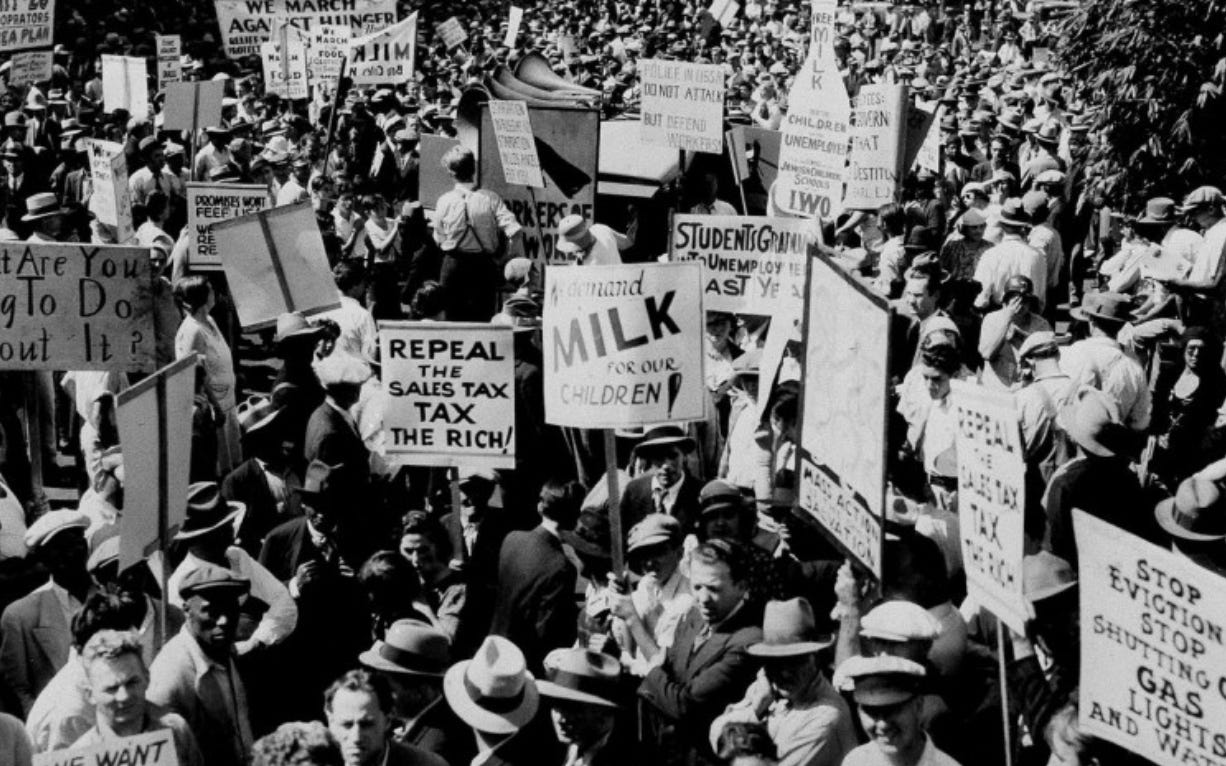The History of Economic Thought in the United States
The political legacy of U.S. fiscal crises
This article first appeared in the Nottingham Economic Review and is available, along with other excellent articles, in NER’s November Report.
Throughout U.S. history, major fiscal crises have not only shaped economic policy, but also altered political ideologies on all sides of the spectrum.
In the 19th century, the U.S. saw a slew of successive crashes due to the absence of central banking, unregulated credit, and gold-backed currency. The stock market featured crashes in 1837, 1873, and 1893, just to name a few. These crises forged America’s first political divide over monetary policy, in which two main ideologies were created: first, there was the “Gold Standard” group, often Republicans, who believed that the U.S dollar should be tied to a stable asset like gold to prevent inflation and general instability. However, the second ideology was called the “Free Silver Movement,” and was backed by many Democrats, and even a new party called the Populists. In response to the 1893 financial crisis, they advocated for unlimited coinage of silver so that the “common man” could pay off his debts with inflated currency. They believed that a Gold standard only benefited the wealthy.
A few decades later, the divide over fiscal policy between Democrats and Republicans once again became exacerbated by a major financial crisis: The Great Depression. Decline in consumer spending, overspeculation, and a huge stock market crash all contributed to the crisis. Interestingly, according to Brittanica, the aforementioned “gold standard, which linked nearly all the countries of the world in a network of fixed currency exchange rates, played a key role in transmitting the American downturn to other countries.” The response by President Franklin D. Roosevelt would change American politics forever. He introduced “the New Deal,” which represented a series of policies and federal programs aimed at establishing a welfare state within the United States. He created safety nets such as Social Security. Critics feared overdependence on government. Advocates lauded the economic resurgence. Yet again, the United States experienced a political divide, this time over the efficacy of a large federal government.
If the New Deal established the framework of modern fiscal politics, later crises exposed its limits. The 1970s brought stagflation: high inflation paired with high unemployment, which to a large extent discredited Keynesian confidence in perpetual spending. In its place arose a conservative economic movement, featuring monetarism and the supply-side revolution. Under Ronald Reagan, tax cuts and deregulation were sold not just as economic policy but as moral restoration. They represented a return to self-reliance after decades of perceived dependency on the state.
The financial crisis in 2008 revived large-scale federal intervention, from bank bailouts to the Obama stimulus. Once again, Americans argued not only about economics but about the meaning of government itself. The Tea Party framed debt as a symbol of moral decay and elite corruption, while progressives saw public spending as the only bulwark against collapse. The COVID-19 pandemic replayed the same script on a grander scale: multi-trillion-dollar relief packages sparking renewed fears of inflation and insolvency.
In the present day, America’s debt problem has never been worse. The underlying problem is clear. There is not enough money for too many problems. The U.S.’s debt now reaches the mark of $38 trillion, and interest payments now make up a larger portion of spending than defense. The country is in a debt spiral, and not one administration since Bill Clinton’s has balanced the federal budget. Today in the United States, the Democrats and Republicans each react in increasingly extreme ways to America’s debt problem: on the right, we see anti-immigration nativism, and on the left, we see politicians like Zohran Mamdani unequivocally support socialist policies.
The Populist Right offers a simple and yet appealing argument. They believe that globalization and immigration have hurt the American economy, taking jobs from native-born Americans and shipping those jobs off to countries like Mexico and China. Therefore, when President Trump came along and promised protective tariffs to reshore domestic industry, many in the country enthusiastically joined him in his mission.
On the other hand, we now see a new movement on the other side of the political spectrum: the Populist Left. The far left has adopted a similarly simple and appealing argument: In reaction to a rising cost of living and limited wage growth, the government must tax billionaires and large corporations, which, unlike the rest of the country, have experienced huge growth over the last decades.
The fact is that the majority of Americans don’t support either extreme: at least unequivocally. However, the two-party system in the U.S. forces the people’s hand. For the time being, American politics will be ever more dominated by these two reductive ideologies.
Looking back at history, it is clear that each fiscal crisis has forced Americans to reconsider their politics. The 19th century asked whether government should control money at all. The 1930s demanded that it rescue the economy. The 21st century questions whether it can still do so in a fractured democracy. The pattern is clear. Economic panics drive ideological change and reinvention. When the market fails, citizens turn to the state; when the state overreaches, they return to the market. Our modern world is no different. While everyday Americans may be keen to hit the panic button on the extreme change in our country, we must remember the words of Ecclesiastes, who in the Bible wisely pointed out that “there is nothing new under the sun.”


